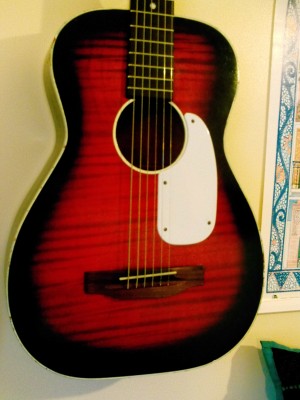-----------------------------------------------------------
*** NEW LISTING - 27/10/2024 ***
*** UPDATE - 24/11/2024 - NOW SOLD!....and on it's way to buyer in Suffolk!
*** ALSO AVAILABLE SOON...I DO HAVE ANOTHER SAME MODEL STELLA H931 ALMOST READY TO GO...PLEASE ENQUIRE!....ALSO SEE PAGE AS3!
------------------------------------------------------------
I have sold many 1940s, '50s and '60s Harmony-made Stella guitars over the years, in their many variations of the same basic model.....quite a few of them are included in the models currently ready to "pre-order" & restore, on this and adjoining pages.
The H931 is one of the fixed-bridge versions of the Stella models which Harmony made, and are less numerous than the variety of floating bridge versions.

Stock Number: VTG1502.
The Stella H931 in this form was only made by Harmony, Chicago during the period 1964 to 1966, and has the distinctive Harmony "Redburst" finish, pioneered on the Monterey archtop model. Original ink date stamp is clearly visible, reading S-64, confirming that the guitar is from one of the 1964 production runs.
This particular example had had some work carried out before it came to me, possibly including a neck reset, in addition to the fitting of a Rosewood string through bridge, in place of the original bridge unit, also of string-through design.
It has marginally slimmer nut width than the 1 3/4" which is standard for Harmony Stella guitars....the 43.5mm. dimension is a little over 1 11/16ths. This gives slightly narrower string spacing at the nut of 37.5mm. I have only encountered a couple of Harmony Stellas with nut widths varying from standard, and in this case the difference is so slight as to be hardly noticeable, and gives a rather odd imperial dimension, as the maker's would have used. Nevertheless, there is no sign of any alteration from manufacture.
Set-up on the guitar will allow standard fretted play, or bottleneck style play, albeit with a little higher than usual action....not a problem for blues styles of play, due to lower string tension on shorter 24.25" scale. Options available include using nut riser, raising the action for full time bottleneck or slide play...even further for lap slide style playing would also be an option.

Condition....essentially original, except for a replaced bridge...finish & colour in my view as good as you are likely to find on a guitar of this type, at 60 years old - inevitably there is a little edge wear, marking & localised finish loss to the painted bindings and other edges and minor surface chips/scratches...also there are filled screw holes at the rear, where someone previously attempted fitting a tailpiece....in the main, really the minimum for one of this type and age.
Restoration work completed includes....
As the neck joint appeared secure, and the neck angle workable, it remained to remove inaccuracies and slight misalignment in the fingerboard, by removing original part worn frets, and re-levelling, maintaining original flat fingerboard profile, prior to installing new frets. All now completed.
Two features of the fingerboard in this case were helpful...the fingerboard has traditional inlayed dot position markers, rather than the factory painted on ones, on so many Stella models, which of course are lost when re-levelling, and have to be replaced....happy to say that original dot inlays survived the levelling process....and also the fingerboard is pressure-dyed Maple, rather than many which are surface coloured, so sanding was not followed by the need to re-colour.
Following re-levelling the nut, which already appears to be a replaced bone unit, has been adjusted and re-fitted, as so has the bone saddle. Here the error in the previous replacement was corrected, and the radiused saddle was adjusted to correctly marry up with the standard Stella flat, un=radiused, fingerboard.
Following initial inspection with the professional luthier I work with, minor work was also carried out in his workshop to glue and secure two very slight top seam separations, and one small side crack, on the line of the internal linings, just adjoining the neck heal. Additional bracing pieces were also installed alongside the soundhole to provide additional reinforcement to that area if the top....and upgrade we have carried out many times on these Stellas.
Other minor work completed includes adding vintage-type bootlace tuner ferrules/bushings, which were not factory installed until later in the '60s, and adjusting the position of the scratchplate, originally fitted out of alignment.
As mentioned bridge is a Rosewood string through replacement unit, previously fitted elsewhere. Slight finish disturbance in front of bridge, may be footprint of original, or caused buy it's removal, but is not in any way disfiguring. Other fittings original and in sound operational condition....one tuning machine key is slightly bent, but has been left rather than risk increasing damage in trying to straighten, but works fine!
The 12th. fret action is within the range I aim for on these parlor blues guitars, at around 3.5mm.....the guitar is therefore not for players who require low action heights, but is an acoustic blues guitar set-up which, with lower string tension due to the shorter scale length, would suit blues players for combined fretted and bottleneck & slide playing styles.
The guitar can be set up for full-time slide (lap style) playing by adding raised bone nut and saddle, to a buyer's requirements, increasing the string action height, if required. It has been strung with a string set of Martin Retro Monel Light gauge 12-54 strings.
There is no case included, but I may be able to offer additional options of period case, of the type these were originally supplied with...not offering modern standards of fit or protection, for which a modern hardshell case, Hiscox Liteflite or PRO11 may be available, or a Gig bag, and the guitar will be packed securely for postage.

